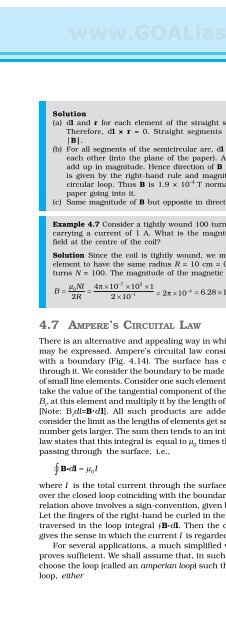- Page 1 and 2:
www.GOALias.blogspot.comMore Books
- Page 4:
www.GOALias.blogspot.comwww.GOALias
- Page 8:
www.GOALias.blogspot.comChapter One
- Page 12:
www.GOALias.blogspot.comneutralise
- Page 18:
www.GOALias.blogspot.comPhysicselec
- Page 22:
www.GOALias.blogspot.comPhysics81.5
- Page 26:
www.GOALias.blogspot.comPhysicsthey
- Page 30:
www.GOALias.blogspot.comPhysicsFIGU
- Page 38:
www.GOALias.blogspot.comPhysicswhic
- Page 42:
www.GOALias.blogspot.comPhysicsEXAM
- Page 46:
www.GOALias.blogspot.comPhysicsFIGU
- Page 50:
www.GOALias.blogspot.comPhysics2h2h
- Page 54:
www.GOALias.blogspot.comPhysicsFIGU
- Page 58:
www.GOALias.blogspot.com26Physicswe
- Page 62:
www.GOALias.blogspot.com28PhysicsFI
- Page 66:
www.GOALias.blogspot.comPhysicsSolu
- Page 70:
www.GOALias.blogspot.comPhysicsdisc
- Page 74:
www.GOALias.blogspot.comPhysicsFIGU
- Page 78:
www.GOALias.blogspot.comPhysics36EX
- Page 82:
www.GOALias.blogspot.com38PhysicsFI
- Page 86:
www.GOALias.blogspot.comPhysicsThe
- Page 90:
www.GOALias.blogspot.comPhysicsSUMM
- Page 94:
www.GOALias.blogspot.comPhysicsFor
- Page 98:
www.GOALias.blogspot.comPhysics11.
- Page 102:
www.GOALias.blogspot.comPhysics1.19
- Page 106:
www.GOALias.blogspot.comPhysics1.32
- Page 110:
www.GOALias.blogspot.comPhysicsto F
- Page 114:
www.GOALias.blogspot.comPhysicsFIGU
- Page 118:
www.GOALias.blogspot.comPhysicsthe
- Page 122:
www.GOALias.blogspot.comPhysics1
- Page 126:
www.GOALias.blogspot.comPhysicsFIGU
- Page 130:
www.GOALias.blogspot.comPhysicsFIGU
- Page 134:
www.GOALias.blogspot.comPhysicsAdd
- Page 138:
www.GOALias.blogspot.comPhysicsEXAM
- Page 142:
www.GOALias.blogspot.comPhysicsthe
- Page 146:
www.GOALias.blogspot.comPhysicsFIGU
- Page 150:
www.GOALias.blogspot.comPhysicsIn a
- Page 154:
www.GOALias.blogspot.com74PhysicsFI
- Page 158:
www.GOALias.blogspot.comPhysicsand
- Page 162:
www.GOALias.blogspot.comPhysicsEXAM
- Page 166:
www.GOALias.blogspot.comPhysicsSolu
- Page 170:
www.GOALias.blogspot.comPhysicsNote
- Page 174:
www.GOALias.blogspot.comPhysicswill
- Page 178:
www.GOALias.blogspot.comPhysics11.
- Page 182:
www.GOALias.blogspot.comPhysics2.9
- Page 186:
www.GOALias.blogspot.comPhysics2.25
- Page 190:
www.GOALias.blogspot.comPhysics(c)
- Page 194:
www.GOALias.blogspot.comPhysicsand
- Page 198:
www.GOALias.blogspot.comPhysicsGEOR
- Page 202:
www.GOALias.blogspot.comPhysicstime
- Page 206:
www.GOALias.blogspot.comPhysicsEXAM
- Page 210:
www.GOALias.blogspot.comPhysicsdepe
- Page 214:
www.GOALias.blogspot.comPhysicsFor
- Page 218:
www.GOALias.blogspot.com106Physicsa
- Page 222:
www.GOALias.blogspot.comPhysicsCons
- Page 226:
www.GOALias.blogspot.comPhysicsFIGU
- Page 230:
www.GOALias.blogspot.comPhysicsExam
- Page 234:
www.GOALias.blogspot.comPhysicsIf w
- Page 238:
www.GOALias.blogspot.comPhysics[Eq.
- Page 242:
www.GOALias.blogspot.comPhysicsEXAM
- Page 246:
www.GOALias.blogspot.comPhysicsA ga
- Page 250: www.GOALias.blogspot.com122PhysicsF
- Page 254: www.GOALias.blogspot.comPhysicsEXAM
- Page 258: www.GOALias.blogspot.comPhysicsPhys
- Page 262: www.GOALias.blogspot.comPhysicsa st
- Page 266: www.GOALias.blogspot.comPhysicsFIGU
- Page 270: www.GOALias.blogspot.comPhysicsChap
- Page 274: www.GOALias.blogspot.comPhysicsHEND
- Page 278: www.GOALias.blogspot.comPhysicsdrif
- Page 282: www.GOALias.blogspot.com138PhysicsF
- Page 286: www.GOALias.blogspot.comPhysics4.4
- Page 290: www.GOALias.blogspot.comPhysicsthe
- Page 294: www.GOALias.blogspot.comPhysics(iii
- Page 298: www.GOALias.blogspot.comPhysicsThe
- Page 304: www.GOALias.blogspot.com(iv) There
- Page 308: www.GOALias.blogspot.com4.8.1 The s
- Page 312: www.GOALias.blogspot.comMoving Char
- Page 316: www.GOALias.blogspot.comMoving Char
- Page 320: www.GOALias.blogspot.comMoving Char
- Page 324: www.GOALias.blogspot.comequilibrium
- Page 328: www.GOALias.blogspot.comMoving Char
- Page 332: www.GOALias.blogspot.comMoving Char
- Page 336: www.GOALias.blogspot.comarrangement
- Page 340: www.GOALias.blogspot.comMoving Char
- Page 344: www.GOALias.blogspot.comEXERCISESMo
- Page 348: www.GOALias.blogspot.comMoving Char
- Page 352:
www.GOALias.blogspot.comChapter Fiv
- Page 356:
www.GOALias.blogspot.comWe begin ou
- Page 360:
www.GOALias.blogspot.comMagnetism a
- Page 364:
www.GOALias.blogspot.comMagnetism a
- Page 368:
www.GOALias.blogspot.comMagnetism a
- Page 372:
www.GOALias.blogspot.comMagnetism a
- Page 376:
www.GOALias.blogspot.comMagnetism a
- Page 380:
www.GOALias.blogspot.com0º41′ E
- Page 384:
www.GOALias.blogspot.comMagnetism a
- Page 388:
www.GOALias.blogspot.comMagnetism a
- Page 392:
www.GOALias.blogspot.comMagnetism a
- Page 396:
www.GOALias.blogspot.comMagnetism a
- Page 400:
www.GOALias.blogspot.comMagnetism a
- Page 404:
www.GOALias.blogspot.comMagnetism a
- Page 408:
www.GOALias.blogspot.comMagnetism a
- Page 412:
www.GOALias.blogspot.comMagnetism a
- Page 416:
www.GOALias.blogspot.comis not mere
- Page 420:
www.GOALias.blogspot.comElectromagn
- Page 424:
www.GOALias.blogspot.comElectromagn
- Page 428:
www.GOALias.blogspot.comElectromagn
- Page 432:
www.GOALias.blogspot.comElectromagn
- Page 436:
www.GOALias.blogspot.comElectromagn
- Page 440:
www.GOALias.blogspot.comElectromagn
- Page 444:
www.GOALias.blogspot.com(iii) Induc
- Page 448:
www.GOALias.blogspot.comwhere n 2l
- Page 452:
www.GOALias.blogspot.comElectromagn
- Page 456:
www.GOALias.blogspot.comElectromagn
- Page 460:
www.GOALias.blogspot.comElectromagn
- Page 464:
www.GOALias.blogspot.comElectromagn
- Page 468:
www.GOALias.blogspot.comElectromagn
- Page 472:
www.GOALias.blogspot.comChapter Sev
- Page 476:
www.GOALias.blogspot.comAlternating
- Page 480:
www.GOALias.blogspot.com7.3 REPRESE
- Page 484:
www.GOALias.blogspot.comAlternating
- Page 488:
www.GOALias.blogspot.com7.5 AC VOLT
- Page 492:
www.GOALias.blogspot.comAlternating
- Page 496:
www.GOALias.blogspot.com7.6.1 Phaso
- Page 500:
www.GOALias.blogspot.comAlternating
- Page 504:
But to hear one particular radio st
- Page 508:
www.GOALias.blogspot.comvalue of Q,
- Page 512:
www.GOALias.blogspot.comAlternating
- Page 516:
www.GOALias.blogspot.comAlternating
- Page 520:
The LC oscillation is similar to th
- Page 524:
www.GOALias.blogspot.comAlternating
- Page 528:
www.GOALias.blogspot.comAlternating
- Page 532:
www.GOALias.blogspot.comAlternating
- Page 536:
www.GOALias.blogspot.comAlternating
- Page 540:
www.GOALias.blogspot.comADDITIONAL
- Page 544:
www.GOALias.blogspot.comChapter Eig
- Page 548:
www.GOALias.blogspot.comNow, consid
- Page 552:
www.GOALias.blogspot.coma consequen
- Page 556:
www.GOALias.blogspot.comsucceeded i
- Page 560:
www.GOALias.blogspot.comElectromagn
- Page 564:
www.GOALias.blogspot.comElectromagn
- Page 568:
www.GOALias.blogspot.comWe briefly
- Page 572:
www.GOALias.blogspot.com8.4.6 X-ray
- Page 576:
www.GOALias.blogspot.comElectromagn
- Page 580:
www.GOALias.blogspot.comElectromagn
- Page 584:
www.GOALias.blogspot.com1.25 9.81
- Page 588:
www.GOALias.blogspot.comAnswers2.22
- Page 592:
www.GOALias.blogspot.com3.18 (a) On
- Page 596:
www.GOALias.blogspot.com4.21 (a) A
- Page 600:
www.GOALias.blogspot.comAnswers5.16
- Page 604:
www.GOALias.blogspot.comAnswers(c)
- Page 608:
www.GOALias.blogspot.comAnswers6.14
- Page 612:
www.GOALias.blogspot.comAnswers7.13
- Page 616:
www.GOALias.blogspot.com7.23 4007.2
- Page 620:
www.GOALias.blogspot.com8.13 A body
















